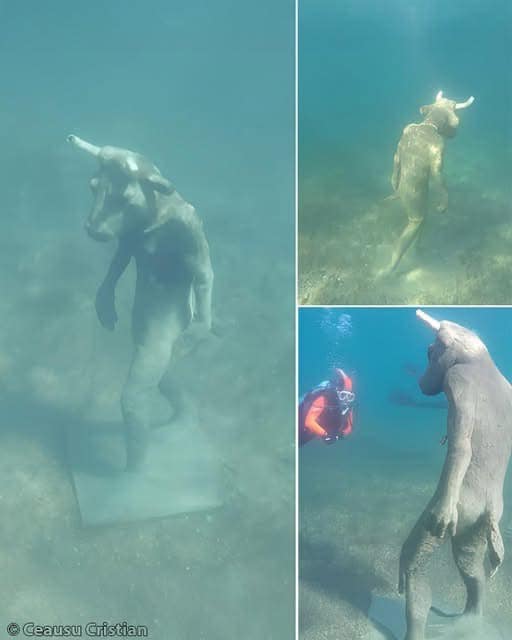In the realm of archaeology and cultural discovery, there are moments that transcend mere fascination and touch the core of human curiosity. One such moment occurred when a 23-year-old man named Cristian made an extraordinary and unexpected discovery while kayaking on the serene waters of Lake Mari Menuco in Patagonia, Argentina. As he glided across the surface, enjoying a tranquil day on the lake, Cristian’s attention was suddenly caught by a startling sight beneath the water—a massive sculpture of a Minotaur, a creature rooted in ancient mythology, possessing the body of a man and the head of a bull. What initially appeared to be a bizarre illusion soon revealed itself to be a tangible, awe-inspiring artifact submerged in the depths.

Cristian described his first reaction with unfiltered honesty: “There I saw it, a Minotaur. It terrified me at first. There are numerous rumors about that lake that we all laugh at, but I believe there is some truth to the stories.” His words echo the universal experience of encountering something that challenges one’s sense of reality. For years, local tales had whispered of strange phenomena in the lake, often dismissed as folklore or playful exaggeration. Yet, here was something real, something monumental that seemed to bridge the gap between myth and reality.
Driven by a mix of fear, curiosity, and wonder, Cristian and his companions decided to learn more about this mysterious sculpture. It quickly became apparent that the Minotaur was far more than an ordinary statue. Its massive form, partially hidden beneath the water’s surface, seemed deliberately positioned, designed not just as an object of art but as a message—one that begged for interpretation.
In seeking to understand the deeper significance of this submerged figure, Cristian turned to the beliefs and traditions of the indigenous Mapuche people, the original inhabitants of the region. The Mapuche worldview is deeply spiritual, recognizing that every element of nature is imbued with a protective force known as “Gen Ko.” This belief holds that all aspects of the natural world—land, water, air—are guarded by these spiritual energies, which demand respect and balance from humanity.
Lefxaru Nawel, a representative of the Mapuche Confederation of Neuquén, provided insight into the meaning of “Gen Ko,” explaining, “In our tradition, all elements, in general, have their Gen, and ‘Ko’ signifies water. So ‘Gen Ko’ refers to the protecting energies of water.” From this perspective, the Minotaur submerged in Lake Mari Menuco may not simply be a relic or artistic creation. It could represent a manifestation of Gen Ko itself—a guardian of the lake, a symbolic warning against the damage inflicted upon the environment.
Lake Mari Menuco, like much of Patagonia, is surrounded by oil wells and industrial development. These human interventions have raised concerns among environmentalists and indigenous communities alike. The presence of the Minotaur, especially in a location burdened by ecological strain, may serve as a silent protest or a spiritual beacon, alerting observers to the need for harmony with the natural world. In this context, the Minotaur’s unsettling gaze from below the surface is not one of menace, but of mourning—a cry for the restoration of balance and respect.
Cristian’s adventure did not end with the Minotaur. As he and his friends continued their exploration of the lake, they encountered another extraordinary find: a massive sunken mask located near the original sculpture. Measuring an impressive 1.4 meters by 1 meter, the mask bore an inscription carved into its cheekbones: “Eternal Journey.” This phrase, enigmatic and evocative, deepened the mystery surrounding the artifacts. Though Cristian was unable to dive down and physically touch the sculptures due to their depth, the encounter left a lasting impression.
The design of both the Minotaur and the mask appeared intentional, as though they were meant to be seen from above—perhaps to captivate those passing over the lake, urging them to contemplate their relationship with nature. The phrase “Eternal Journey” may allude to the timeless bond between humanity and the environment, and the ongoing responsibility to safeguard the Earth’s resources for future generations.
While the origins of the submerged Minotaur and mask remain unknown, their message is clear. They remind us of the profound connections between ancient cultures and the natural world. These artifacts are more than submerged sculptures—they are storytellers, speaking through time about the need for respect, reverence, and caution. The legends of the Mapuche people, paired with modern-day environmental concerns, find a vivid and moving expression in these creations.
For modern observers, Cristian’s discovery is a call to reflect. It invites us to consider not only the legends and beliefs of indigenous peoples but also the pressing need to listen to the Earth’s warnings. Whether one interprets the Minotaur as a spiritual guardian, an artistic protest, or a historical curiosity, its presence beneath the waters of Lake Mari Menuco is a powerful symbol. It bridges myth and reality, the past and the present, urging us to take heed.
In the end, this story serves as a potent reminder that nature is not a silent bystander. Through mystery, myth, and monument, it speaks—and it is up to us to listen. The submerged Minotaur of Patagonia, discovered by a young kayaker with an adventurous spirit, is more than a relic. It is a testament to the enduring relationship between people and the planet, and a compelling argument for why that relationship must be cherished and preserved.





